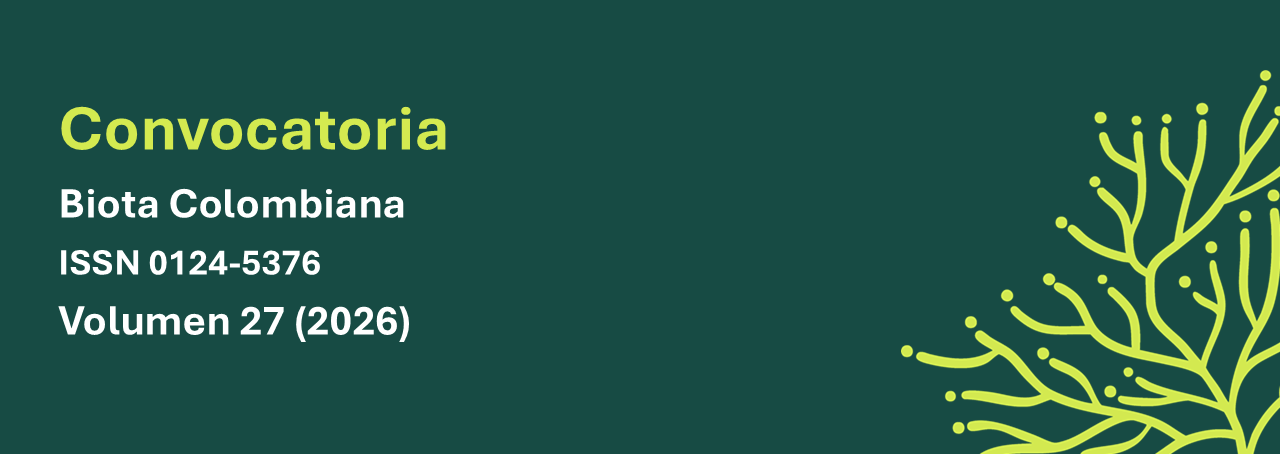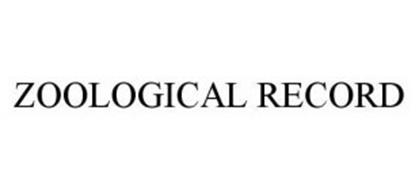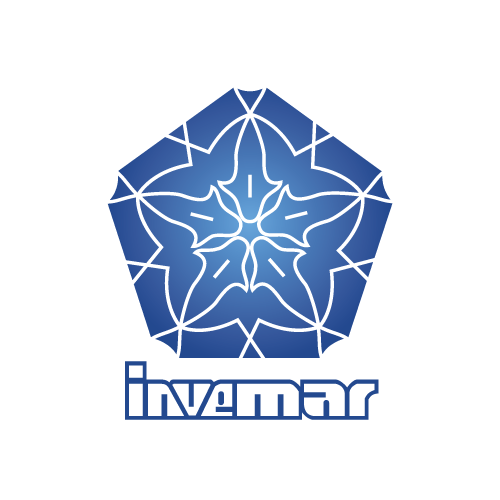Abstract (en):
Abstract (es):
Como resultado de la exploración de áreas en postconflicto enmarcada en el proyecto Colombia BIO,
se realizó la descripción de una nueva especie de Scinax con huesos verdes, asignable al clado de S.
ruber. Esta nueva especie es endémica de los bosques subandinos periféricos del valle medio del río
Magdalena en Colombia. Esta entidad biológica fue previamente identificada en la literatura científica
como Scinax “A” y se caracteriza por su tamaño mediano (28,6-31,1 mm), su patrón cromático y su
vocalización, similar al balido de una cabra, con una duración de 0,21-0,47 s, y frecuencia dominante
entre 2184-3218 Hz. Sus características larvales en conjunto, permiten diferenciarla claramente de otras
especies del género en la región transinterandina de Colombia. Con esta, ascienden a 18 las especies de
Scinax documentadas en el territorio colombiano.
Keywords:
Amphibia, Bioacustics, Tadpoles, Scinaxinae, Taxonomy (en)
References
Altig, R. y McDiarmid, R.W. (1999). Body plan: development and morphology. En McDiarmid, R. W. y Altig, R. (Eds.). Tadpole: The Biology of Anuran Larvae. London: The University of Chicago Press. 458 pp.
Araujo-Vieira, K., Brandão, R. A. y do C. Faria, D. C. (2015). A new species of rock-dwelling Scinax Wagler (Anura: Hylidae) from Chapada dos Veadeiros, central Brazil. Zootaxa, 3915 (1): 52-66.
Araujo-Vieira, K., Valdujo, P. H. y Faivovich, J. (2016). A new species of Scinax Wagler (Anura: Hylidae) from Mato Grosso, Brazil. Zootaxa, 4061 (3): 261-273.
Barrio-Amorós, C. L., Orellana, A. y Chacón-Ortiz., A. (2004). A new species of Scinax (Anura: Hylidae) from the Andes of Venezuela. Journal of Herpetology, 38: 105-112.
Brusquetti, F., Jansen, M., Barrio-Amorós, C. L., Segalla M. V. y Haddad, C. F. B. (2014). Taxonomic review of Scinax fuscomarginatus (Lutz, 1925) and related species (Anura; Hylidae). Zoological Journal of the Linnean Society, 171: 783-821.
Charif, R., Waack, A. y Strickman, L. (2010). Raven Pro 1.4. Ithaca, NY: Cornell Lab of Ornithology.
Chen, H. M. y Combs, C. A. (1999). An alternative anesthesia for amphibians: ventral application of benzocaine. Herpetological Review, 30 (1): 34.
Cisneros-Heredia, D. F. y Mcdiarmid R. W. (2007). Revision of the characters of Centrolenidae (Amphibia: Anura: Athesphatanura), with comments on its taxonomy and the description of new taxa of glassfrogs. Zootaxa, 1572: 1-82.
Cocroft, R. B. y Ryan, M. J. (1995). Patterns of advertisement call evolution in toads and chorus frogs. Animal Behaviour, 49 (2): 283-303.
Conte, C. E., Araujo-Vieira, K., Crivellari, L. B. y Berneck, B.V. (2016). A new species of Scinax Wagler (Anura: Hylidae) from Paraná, Southern Brazil. Zootaxa, 4193 (2): 245-265.
Cruz, C. A. G., Nunes, I. y Lima M. (2011). A new Scinax Wagler belonging to the S. catharinae clade (Anura: Hylidae) from the State of Alagoas, northeastern Brazil. Zootaxa, 3096: 18-26.
De Carvalho, T. R., Martins L. B. y Giaretta A. A. (2015). The complex vocalization of Scinax cardosoi (Anura: Hylidae), with comments on advertisement calls in the S. ruber Clade. Phyllomedusa: Journal of Herpetology, 14 (2): 127-137.
De La Riva, I. (1993). A new species of Scinax (Anura, Hylidae) from Argentina and Bolivia. Journal of Herpetology, 27 (1): 41-46.
Dinerstein, E., Olson, D. M., Graham, D. J., Webster, Primm, A. L. S. A., Bookbinder M. P., Ledec G. y Young. K. R. (1995). A conservation assessment of the terrestrial ecoregions of Latin America and the Caribbean. Washington D. C.: World Bank. 174 pp.
Duellman, W. E. (1970). Hylid frogs of Middle America. Monographs of the Museum of Natural History, University of Kansas, 1-2: 1-753.
Duellman, W. E. (1972). A new species of Hyla from Amazonian Ecuador. Copeia, 1972: 265-271. Duellman, W. E. (1973). Descriptions of new hylid frogs from Colombia and Ecuador. Herpetologica, 29: 219-227.
Duellman, W. E. (1986). Two new species of Ololygon (Anura: Hylidae) from the Venezuelan Guyana. Copeia, 1986: 864-870.
Duellman, W. E. y Pyles, R. A. (1983). Acoustic resource partitioning in anuran communities. Copeia, 639-649.
Duellman, W. E. y Wiens, J. J. (1993). Hylid frogs of the genus Scinax Wagler, 1830, in Amazonian Ecuador and Peru. Occasional Papers of the Museum of Natural History, University of Kansas, 153: 1-57.
Duellman, W. E., Marion, A. B. y Hedges, S. B. (2016). Phylogenetics, classification, and biogeography of the treefrogs (Amphibia: Anura: Arboranae). Zootaxa, 4104 (1): 1-109.
Faivovich, J. (2002). A cladistic analysis of Scinax (Anura: Hylidae). Cladistics, 18 (4): 367-393.
Faivovich, J., Haddad, C. F., Garcia, P. C., Frost, D. R., Campbell, J. A. y Wheeler, W. C. (2005). Systematic review of the frog family Hylidae, with special reference to Hylinae: phylogenetic analysis and taxonomic revision. Bulletin of the American Museum of Natural History, 294: 1-240.
Fouquette Jr., M. J. y Pyburn, W. F. (1972). A new Colombian treefrog of the Hyla rubra complex. Herpetologica, 28: 176-181.
Fouquet, A., Vences, M., Salducci, M. D., Meyer, A., Marty, C., Blanc, M., y Gilles, A. (2007). Revealing cryptic diversity using molecular phylogenetics and phylogeography in frogs of the Scinax ruber and Rhinella margaritifera species groups. Molecular phylogenetics and evolution, 43 (2): 567-582.
Gosner, K. L. (1960). A simplified table for staging anuran embryos and larvae with notes on identification. Herpetologica, 16 (3): 183-190.
Guayasamin, J. M., Lehr, E., Rodríguez, D. y Aguilar, C. (2006). A new species of glass frog (Centrolenidae: Cochranella ocellata Group) from central Peru. Herpetologica, 62 (2): 163-172.
Guimaraes, C. S., Peixoto, M. A. A., Lacerda, J. V. A. y Feio, R. N. (2014). The tadpole of Scinax cosenzai (Anura: Hylidae). Salamandra, 50 (2): 99-104.
Juncá, F. A., Napoli M. F., Nunes, I., de A. Mercês, E. y de Abreu, R. O. (2015). A new species of the Scinax ruber clade (Anura, Hylidae) from the Espinhaço Range, northeastern Brazil. Herpetologica, 71 (4): 299-309.
Köhler, J., Jansen, M., Rodríguez, A., Kok, P. J. R., Toledo, L. F., Emmrich, M., Glaw, F., Haddad, C. F. B., Rödel M. O. y Vences, M. (2017). The use of bioacoustics in anuran taxonomy: theory, terminology, methods and recommendations for best practice. Zootaxa, 4251 (1): 1-124.
Lannoo, M. J. (1987). Neuromast topography in anuran amphibians. Journal of Morphology, 191 (2): 115-129.
Lourenço, A., Carvalho, A., Baeta, D., Pezzuti, T. L. y Leite, F. (2013). A new species of the Scinax catharinae group (Anura, Hylidae) from Serra da Canastra, southwestern state of Minas Gerais, Brazil. Zootaxa, 3613 (6): 573-588.
Lourenco, A. C. C., Zina, J., Catroli, G. F., Kasahara, S., Faivovich, J. y Haddad, C. F. (2016). A new species of the Scinax catharinae group (Anura: Hylidae) from southeastern Brazil. Zootaxa, 4154(4): 415-435.
McDiarmid, R. W. y Altig, R. (Eds.). (1999). Tadpoles: the biology of anuran larvae. University of Chicago Press. 458 pp.
Myers, C. y Duellman, W. (1982). A New Species of Hyla from Cerro Colorado, and other tree frog records and geographical notes from western Panama. American Museum Novitates, 2752: 1-32.
Napoli, N. F. y Caramaschi, U. (1998). Duas novas espécies de Hyla Laurenti, 1768 do Brasil central afins de H. tritaeniata Bokermann, 1965 (Amphibia, Anura, Hylidae). Boletim do Museu Nacional, Nova Série, Zoologia, 391: 1-12.
Nieto-Castro, M. (1999). Estudio preliminar de las especies del género Scinax (Amphibia: Anura: Hylidae) en Colombia. Revista de la Academia Colombiana de Ciencias Exactas, Físicas y Naturales, 23 (Suplemento Especial): 339-346.
Nunes, I., Carvalho Jr., R. R. y Pereira, E.G. (2010). A new species of Scinax Wagler (Anura: Hylidae) from Cerrado of Brazil. Zootaxa, 2514: 24-34.
Nunes, I. y Pombal, Jr., J. P. (2011). A new snouted treefrog of the speciose genus Scinax Wagler (Anura, Hylidae) from northeastern Brazil. Herpetologica, 67 (1): 80-88.
Olson, D. M. y Dinerstein, E. (2002). The Global 200: Priority ecoregions for global conservation. Annals of the Missouri Botanical Garden, 89: 199-224.
Pyburn, W. F. (1973). A new hylid from the Llanos of Colombia. Journal of Herpetology, 7: 297-301.
Pyburn, W. F. (1992). A new tree frog of the genus Scinax from the Vaupes River of northwestern Brazil. Texas. Journal of Science, 44: 405-411.
Pyburn, W. F. (1993). A new species of dimorphic tree frog, genus Hyla (Amphibia: Anura: Hylidae), from the Vaupés River of Colombia. Proceedings of the Biological Society of Washington, 106: 46-50.
Pyburn, W. F. y Fouquette, Jr., M. J. (1971). A new striped treefrog from central Colombia. Journal of Herpetology, 5: 97-101.
Restrepo, A., Molina-Zuluaga, C., Hurtado, J. P., Marín C. M. y Daza J. M. (2017). Amphibians and reptiles from two localities in the northern Andes of Colombia. Check List, 13 (4): 203-237.
Savage, J. M. y Heyer W. R.. (1967) Variation and distribution in the tree-frog genus Phyllomedusa in Costa Rica, Central America. Beitrage zur Neotropischen Fauna, 5: 111-131.
Silva-Soares, T., Costa, P. N., Ferreira, R. B. y Weber, L. N. (2010). The tadpole of the hylid Faivovich, J., Haddad, C. F., Garcia, P. C., Frost, D. R., Campbell, J. A. y Wheeler, W. C. (2005). Systematic review of the frog family Hylidae, with special reference to Hylinae: phylogenetic analysis and taxonomic revision. Bulletin of the American Museum of Natural History, 294: 1-240.
Fouquette Jr., M. J. y Pyburn, W. F. (1972). A new Colombian treefrog of the Hyla rubra complex. Herpetologica, 28: 176-181.
Fouquet, A., Vences, M., Salducci, M. D., Meyer, A., Marty, C., Blanc, M., y Gilles, A. (2007). Revealing cryptic diversity using molecular phylogenetics and phylogeography in frogs of the Scinax ruber and Rhinella margaritifera species groups. Molecular phylogenetics and evolution, 43 (2): 567-582.
Gosner, K. L. (1960). A simplified table for staging anuran embryos and larvae with notes on identification. Herpetologica, 16 (3): 183-190.
Guayasamin, J. M., Lehr, E., Rodríguez, D. y Aguilar, C. (2006). A new species of glass frog (Centrolenidae: Cochranella ocellata Group) from central Peru. Herpetologica, 62 (2): 163-172.
Guimaraes, C. S., Peixoto, M. A. A., Lacerda, J. V. A. y Feio, R. N. (2014). The tadpole of Scinax cosenzai (Anura: Hylidae). Salamandra, 50 (2): 99-104.
Juncá, F. A., Napoli M. F., Nunes, I., de A. Mercês, E. y de Abreu, R. O. (2015). A new species of the Scinax ruber clade (Anura, Hylidae) from the Espinhaço Range, northeastern Brazil. Herpetologica, 71 (4): 299-309.
Köhler, J., Jansen, M., Rodríguez, A., Kok, P. J. R., Toledo, L. F., Emmrich, M., Glaw, F., Haddad, C. F. B., Rödel M. O. y Vences, M. (2017). The use of bioacoustics in anuran taxonomy: theory, terminology, methods and recommendations for best practice. Zootaxa, 4251 (1): 1-124
Lannoo, M. J. (1987). Neuromast topography in anuran amphibians. Journal of Morphology, 191(2): 115-129.
Lourenço, A., Carvalho, A., Baeta, D., Pezzuti, T. L. y Leite, F. (2013). A new species of the Scinax catharinae group (Anura, Hylidae) from Serra da Canastra, southwestern state of Minas Gerais, Brazil. Zootaxa, 3613 (6): 573-588.
Lourenco, A. C. C., Zina, J., Catroli, G. F., Kasahara, S., Faivovich, J. y Haddad, C. F. (2016). A new species of the Scinax catharinae group (Anura: Hylidae) from southeastern Brazil. Zootaxa, 4154(4): 415-435.
McDiarmid, R. W. y Altig, R. (Eds.). (1999). Tadpoles: the biology of anuran larvae. University of Chicago Press. 458 pp.
Myers, C. y Duellman, W. (1982). A New Species of Hyla from Cerro Colorado, and other tree frog records and geographical notes from western Panama. American Museum Novitates, 2752: 1-32.
Napoli, N. F. y Caramaschi, U. (1998). Duas novas espécies de Hyla Laurenti, 1768 do Brasil central afins de H. tritaeniata Bokermann, 1965 (Amphibia, Anura, Hylidae). Boletim do Museu Nacional, Nova Série, Zoologia, 391: 1-12.
Nieto-Castro, M. (1999). Estudio preliminar de las especies del género Scinax (Amphibia: Anura: Hylidae) en Colombia. Revista de la Academia Colombiana de Ciencias Exactas, Físicas y Naturales, 23 (Suplemento Especial): 339-346.
Nunes, I., Carvalho Jr., R. R. y Pereira, E.G. (2010). A new species of Scinax Wagler (Anura: Hylidae) from Cerrado of Brazil. Zootaxa, 2514: 24-34.
Nunes, I. y Pombal, Jr., J. P. (2011). A new snouted treefrog of the speciose genus Scinax Wagler (Anura, Hylidae) from northeastern Brazil. Herpetologica, 67 (1): 80-88.
Olson, D. M. y Dinerstein, E. (2002). The Global 200: Priority ecoregions for global conservation. Annals of the Missouri Botanical Garden, 89: 199-224.
Pyburn, W. F. (1973). A new hylid from the Llanos of Colombia. Journal of Herpetology, 7: 297-301.
Pyburn, W. F. (1992). A new tree frog of the genus Scinax from the Vaupes River of northwestern Brazil. Texas Journal of Science, 44: 405-411.
Pyburn, W. F. (1993). A new species of dimorphic tree frog, genus Hyla (Amphibia: Anura: frog Scinax belloni (Anura: Hylidae). Zootaxa, 2727: 63-68.
Sturaro, M. J. y Peloso, P. L. V. (2014). A new species of Scinax Wagler, (1830) (Anura: Hylidae) from the middle Amazon River basin, Brazil. Papéis Avulsos de Zoologia, 54 (2): 9-23.
Suarez, A. y Lynch J. D. (2011). Clave ilustrada de los renacuajos en las tierras bajas al oriente de los Andes, con énfasis en Hylidae. Caldasia, 33 (1): 235-270.
UICN. (2001). Categorías y criterios de la lista roja de la UICN: Versión 3.1. Comisión de Supervivencia de Especies de la UICN. UICN, Gland, Suiza y Cambridge, Reino Unido. ii +33 pp.
How to Cite
The works published in the journals of the Alexander von Humboldt Biological Resources Research Institute are subject to the following terms, in relation to copyright:
1. The patrimonial rights of the published works are assigned to Instituto de Investigación de Recursos Biológicos Alexander von Humboldt. The authors or institutions that elaborate the document agree to transfer the patrimonial rights to the Humboldt Institute with the sending of their articles, which allows, among other things, the reproduction, public communication, dissemination and dissemination of works.
2. The works of digital editions are published under a Creative Commons Colombia license:
Creative Commons License
This work is licensed under a Creative Commons Atribución-NoComercial-SinDerivar 4.0 Internacional.
> Attribution - Non-commercial - No Derivative: This license is the most restrictive of the six main licenses, it only allows others to download the works and share them with others, as long as their authorship is acknowledged, but they cannot be changed in any way, nor can they be used commercially.
3. The authors, when submitting articles to the editorial process of the magazines published by the Humboldt Institute, accept the institutional dispositions on copyright and open access.
4. All items received will be subjected to anti-plagiarism software. The submission of an article to the magazines of the Humboldt Institute is understood as the acceptance of the review to detect possible plagiarism.
5. The works submitted to the editing process of the magazines of the Humboldt Institute must be unpublished.


















